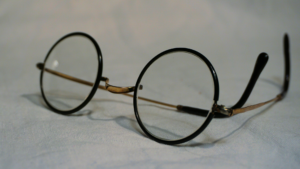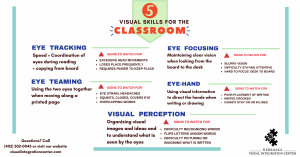Irlen / Colored Lenses

What are Irlen Lenses?
The term Scotopic Sensitivity Syndrome (SSS), also known as Irlen Syndrome, was introduced by Helen Irlen, M.A., to describe a perceptual dysfunction related to “subjective difficulties with light, luminance, intensity, wavelength, and color contrast.” Essentially this means difficulty processing color and contrast changes such as black print on a white background. Irlen claims approximately 50% of the reading disability and dyslexic populations have this syndrome. According to Irlen, individuals with this condition must use more effort and energy when reading because they are inefficient readers who see the printed page differently from the good reader. She suggests a large number of these individuals can be successfully treated using tinted lenses called “Irlen Lenses.”
Irlen Syndrome or a Functional Visual Issue?
Optometrists have brought up a number of concerns about patients that are considered candidates for Irlen Syndrome. The first issue centers around the screening method used for diagnosis to determine symptoms. Results are remarkably similar to symptoms associated with a binocular vision (eye teaming), accommodative (eye focusing), and ocular motility (eye coordination) disorder as defined by the COVD Quality of Life Questionnaire. Reading symptoms associated with both Irlen Syndrome and a functional visual issue include: headaches, eyestrain, excessive blinking & rubbing of the eyes, squinting, fluctuating blur, intermittent double vision, movement of words on a page, loss of place, skipping and re-reading lines.
A study performed by Scheiman, OD et al. reported 95% of subjects identified as good candidates for Irlen filters had identifiable visual issues. However, Irlen Syndrome is described by Irlen advocates as a diagnosis unrelated to any visual issue. Attempts have been made to direct Irlen candidates to an eye examination prior to Irlen diagnostic testing. The study by Scheiman, OD et al investigated this and found 57% of their subjects had some form of eye care and were told their vision is “normal” in spite of binocular vision (eye teaming), accommodative (eye focusing), and ocular motility (eye coordination) issues being present. This is where a referral to an appropriate vision care provider is important. Unfortunately some eye care professionals are not including binocular, accommodative and oculomotor testing into their eye examination and without testing for these visual issues, individuals will not receive the necessary vision therapy to address their problems.
The Need for a Functional / Binocular Vision Examination and Vision Therapy
From this research it’s evident many individuals with undiagnosed functional-based visual issues are seeking treatment with Irlen filters. These patients need a proper binocular vision examination to rule out visual issues that are likely interfering with school and life. Another study by Blaskey, Scheiman, et al identified all subjects in the Irlen filter subject group reported a reduction in symptoms and improved comfort, however they still had “clinically significant vision anomalies after treatment with Irlen filters.”
This study also included subjects treated with Vision Therapy and found significant overall improvements to the extent that those who were previously determined as a candidate for Irlen lenses (by Irlen survey), then scored below the level where they would be considered a candidate.
Another interesting finding reported was a combination of Irlen filters after successful Vision Therapy resulted in additional benefits. The reason for this remains uncertain, but this details the importance of collaboration among health care professionals ensuring the child/patient receives the best care possible.
How our Examinations are Different
At Nebraska Visual Integration Center we see patients for a myriad of functional-based visual issues. These visual issues are often not identified during a routine or general eye examination. A general eye examination will typically consist of an assessment of eye health and eye sight. These are two very important aspects of vision care, but further testing is needed to determine performance of the visual system and how it can impact classroom performance. Deficits in binocular (eye teaming), accommodation (eye focusing), and oculomotor coordination (eye control) must be identified. At our office we are dedicated to providing the best functional vision care to allow each patient to perform at their maximum potential in school, work, and life.
How Can we Help?
Please contact our Omaha Vision Therapy office at (402) 502-0043 or email: admin@visualintegrationcenter with any questions. More information can be found at our Website and Facebook. We’d be happy to explain how our process of vision care is different and how we can help you / your child.


